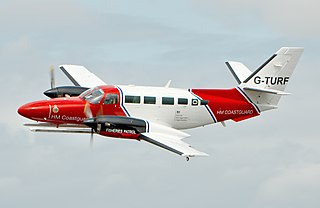
The AEA Explorer is a large single-engine utility aircraft.

The Antonov An-38 is a stretched and upgraded version of Antonov's earlier An-28. It is a twin-engined turboprop transport aircraft, designed by the Antonov Design Bureau in Kyiv, Ukraine. Production is in Novosibirsk, Russia, but some crucial parts are also made in Ukraine and Belarus. It first flew in 1994, and received international flight certification in April 2000. A total of 11 were built and 2 remain in airline service as of August 2019. A recent documentary says that only one remains in service with ALROSA Airlines in 2021.

The Murphy Moose is a Canadian high-wing utility light aircraft produced in kit form by Murphy Aircraft of Chilliwack, British Columbia for amateur construction. The Moose can be purchased as a "quick-build" kit which comes partly pre-assembled.
The Interceptor 400 was a turboprop-powered single-engined light aircraft developed from the Meyers 200 single-engine piston plane. It attracted buyers but was unable to obtain adequate manufacturing financing, and was perhaps too far ahead of its time. In the late 1960s and early 1970s, at the time of its development, the market for single-engined turboprops was still a decade away.

The PAC Cresco is a turboprop-powered derivative of the Fletcher FU-24 aerial topdressing aircraft, manufactured by the Pacific Aerospace Corporation in Hamilton, New Zealand. The Cresco was superseded by the PAC P-750 XSTOL in the early 21st century, but in 2019 was returned to production with the first new aircraft being completed 3 December 2020.

The Partenavia P.68, now Vulcanair P68, is a light aircraft designed by Luigi Pascale and initially built by Italian company Partenavia. It made its first flight on 25 May 1970, its type certification was granted on 17 November 1971 and was transferred to Vulcanair in 1998. The original six-seat high-wing monoplane is powered by twin piston engines and is used for light transport and training. The P.68 Observer is an observation aircraft variant, and it was developed in a stretched, 10/11-seat twin turboprop derivative.

The Cessna 425, known as the Corsair and later as the Conquest I, is an eight-seat American pressurized turboprop twin-engined light aircraft. Now out of production, it was built by Cessna Aircraft of Wichita, Kansas, between 1980 and 1986.

The Piper PA-31T Cheyenne is a turboprop development of the earlier PA-31P Pressurized Navajo.

The Reims-Cessna F406 Caravan II is a turboprop twin engine utility aircraft manufactured and designed by Reims Aviation in cooperation with Cessna.

The Partenavia P.64B/P.66B Oscar is an Italian two/four-seat, single-engined, high-wing monoplane built by Partenavia.

The Piaggio P.166 is an Italian twin-engine pusher-type utility aircraft developed by Piaggio Aero. The aircraft model name was Portofino, and is also known as Albatross in South African military service.

ENAER T-35 Pillán is a Chilean propeller-driven basic trainer aircraft. The student and the instructor sit in tandem. Production ceased in 1991 after 7 years but restarted briefly in 1998.

The type designation Dornier Do 28 comprises two different twin-engine STOL utility aircraft, manufactured by Dornier Flugzeugbau GmbH. Most of them served with the German Air Force and Marineflieger and other air forces around the world in the communications and utility role. The Do 28 series consists of the fundamentally different Do 28 A/B (1959) and Do 28 D Skyservant (1966).
The SIAI-Marchetti SM.101 was a 1940s Italian single-engined light transport cabin monoplane designed and built by SIAI-Marchetti.

The Vulcanair SF.600 Canguro was a feederliner developed in Italy in the late 1970s. Despite a number of attempts to put the aircraft into series production, only a small number were ever built. The Canguro was a high-wing cantilever monoplane of conventional configuration with a fuselage of rectangular cross-section and a high-set tail. The tricycle undercarriage was not retractable, and its main units were carried on sponsons on the fuselage sides. SIAI Marchetti provided funding towards the construction of the prototype, and constructed this aircraft at the former Aviamilano plant. After flight testing proved positive, the type was put on sale, but failed to attract buyers in any number, even when the original piston engines were exchanged for turboprops and retractable undercarriage was offered as an option.
The Hongdu N-5,, originally known as the Nanchang N-5, is a Chinese agricultural aircraft. First flown in 1989, and entering into production in 1992, the N-5 is a single-engined low-wing monoplane, and is available in versions powered by a piston engine or a turboprop.

The Creative Flight Aerocat is a Canadian mid-wing, all composite, four passenger experimental aircraft that can be configured for amphibious float operations. Under development since 1998, the aircraft is intended to be supplied in kit form by Creative Flight of Haliburton, Ontario, for amateur construction. The company has since been renamed Auriga Design.
The Cameron P-51G is an American two-seat turboprop representation of the 1940s North American P-51 Mustang, designed and built by Cameron & Sons Aircraft of Coeur d'Alene, Idaho for sale as completed aircraft or kits for amateur construction.

The MSW Votec 322 is a Swiss two-seat low-wing monoplane based on the Rihn DR-107 One Design and designed for amateur construction by MSW Aviation of Wohlen.

The Caproni Ca.193 was an Italian liaison and air-taxi aircraft that was offered to the Italian Air Force as an instrument flight trainer and to the Navy for liaison. Design work started in 1945 and only the prototype was built. It was the last aircraft the Caproni company designed and built in Milan.
















